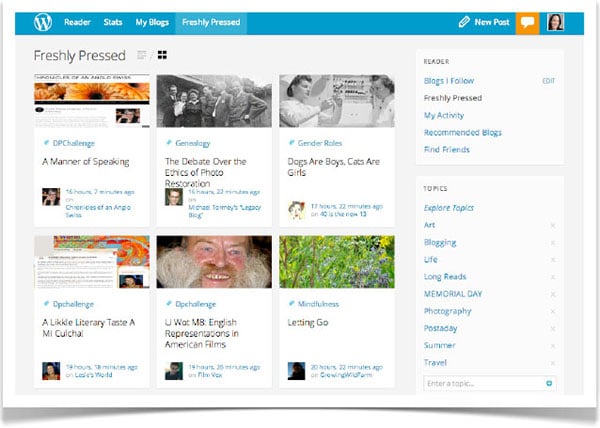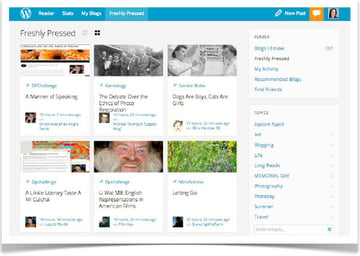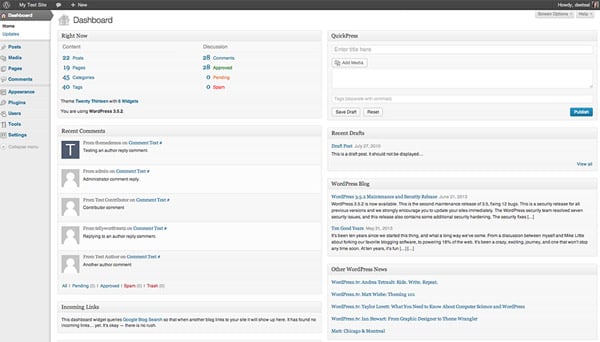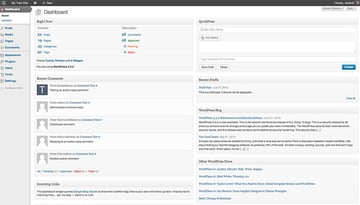Choose between WordPress.com and WordPress.org
Sep 03, 2023 pm 09:57 PMI do a lot of training with WordPress users, whether in classes, one-on-one with clients, or at meetups. I find running these courses both rewarding and challenging, and I really enjoy seeing people leave at the end of the day, or come into a session with an "I think I finally figured it out" look on their faces.
One of the conversations that keeps popping up in all of the training revolves around the differences between WordPress.com and WordPress.org. Specifically, the difference between a free hosted WordPress service and downloading a free copy of WordPress and hosting it yourself.
While the core of the software is the same, and the look and feel of everything you do when managing your website from the dashboard is the same, there are some key differences you should be aware of if you're in the process of deciding which options Suitable for you.
The most basic difference between the two is that WordPress.com puts your site into a network of sites, all essentially running from one WordPress instance, while WordPress.org takes your own copy of WordPress and Run it for yourself.
WordPress.com



On the surface, WordPress.com is indeed attractive, not least of which is that it’s free. It's also attractive because it's fully managed and you don't have to worry about things like behind-the-scenes security (of course, if your password is password1234, you're on your own), updates, and Maintenance; WordPress.com takes care of this for you. Finally, the dashboard on WordPress.com is protected by SSL, which is another helpful security measure.
I'm afraid there are some things you have to trade for free factors. Free WordPress.com is ad-supported, so you will have to put up with the ads unless you pay to have them removed. Your server space is limited to 3GB, which isn't too bad if you don't use a lot of photos (or you post photos via Flickr or some external site), but if you really want to add audio files etc. content, you will have to host them elsewhere, or upgrade your account, as you cannot host audio files on WordPress.com without upgrading your space. If you want to have your own personal domain (e.g.
mycorneroftheweb.com) that directs people to your WordPress.com site, you will have to pay for domain mapping. In fact, $13.00 per year is not that expensive, if you purchased the domain from WordPress.com it would also cost you $5.00 per year. That said, there are many additional features you can add to WordPress.com to make it better/smarter/more feature-rich, such as space upgrades, VideoPress, custom CSS, ad removal, premium themes, etc. Understanding what these features are and their associated costs may help you make your decision. You can get more details here.
The biggest disadvantage of WordPress.com is that you can’t extend your site with plugins or many of the cooler features available with self-hosted sites.
You also cannot run your own ads (such as Google AdWords) or other ads from affiliate marketing type services. You might be considered a failure because you have to pay to upgrade features on WordPress.com, whereas a one-time annual hosting fee for self-managed should completely cover your costs (unless you want to include add-ons that might is advanced).
Finally, some types of code (such as JavaScript and iFrames) cannot be pasted into your WordPress.com site or WordPress.com widgets - this is a trade-off for features that keep you and other WordPress.com users safe.
This can be a problem if you want to paste something like a snazzy Twitter widget or a signup form from another provider. Basically, with WordPress.com, you can only use what they deem safe for the entire web (to be fair, they have a lot of people to look out for).
WordPress.org - Self-hosted
If you want complete control, self-hosted WordPress is the best option.



When you set up a self-hosted WordPress installation, you gain total flexibility that you don’t get with WordPress.com. There is a huge library of plugins and themes (free and paid) that you can use to extend and customize your website. You can do anything you want by installing WordPress!
The disadvantage of full control is that it has full responsibility for maintenance and security. Keeping things like plugins, WordPress core, and themes up to date will be up to you or your web developer.
You can customize your theme to your liking without paying any extra to add functionality, and you can install plugins for e-commerce, memberships, and anything else you want WordPress to do.
However, if you are using a plugin that introduces security vulnerabilities, then you will also need to fix and clean up after any breaches that may have occurred. Finally, you must also be responsible for keeping backups of your website. Either using a plugin, or using the tools provided by your host (check with them so you know what backup plan they offer you).
To self-host WordPress, you must purchase the domain and web hosting and set it up yourself. There are articles and tutorials that can make this easier, but do your research before launching into it. Cheap hosting comes at a price, so look for a reputable host with good reviews, and remember, you get what you pay for. A lot of people I know paid for cheap hosting and needed to leave it within a short period of time because their hosting wasn't meeting the needs of their website.
So while with self-hosted WordPress you have more of the world at your fingertips, you also introduce a level of complexity and responsibility into the process. That’s the fun thing for some people like me; if this sounds like a nightmare, then, again, maybe WordPress.com is your best bet.
in conclusion
The best thing about WordPress.com is that it’s free, secure, and easy to manage, making it a great platform to get started with, and the flexibility to upgrade (for a fee) as needed. When you're willing to learn some of the finer, more technical aspects of website management, you can move from .com to .org. The biggest drawback is that you are limited in what you can and cannot do.
The biggest advantage of WordPress.org is that you can do whatever you want on your website, the disadvantage is the learning curve and the responsibility that comes with the freedom.
The above is the detailed content of Choose between WordPress.com and WordPress.org. For more information, please follow other related articles on the PHP Chinese website!

Hot AI Tools

Undress AI Tool
Undress images for free

Undresser.AI Undress
AI-powered app for creating realistic nude photos

AI Clothes Remover
Online AI tool for removing clothes from photos.

Clothoff.io
AI clothes remover

Video Face Swap
Swap faces in any video effortlessly with our completely free AI face swap tool!

Hot Article

Hot Tools

Notepad++7.3.1
Easy-to-use and free code editor

SublimeText3 Chinese version
Chinese version, very easy to use

Zend Studio 13.0.1
Powerful PHP integrated development environment

Dreamweaver CS6
Visual web development tools

SublimeText3 Mac version
God-level code editing software (SublimeText3)

Hot Topics
 How to revert WordPress core update
Jul 02, 2025 am 12:05 AM
How to revert WordPress core update
Jul 02, 2025 am 12:05 AM
To roll back the WordPress version, you can use the plug-in or manually replace the core file and disable automatic updates. 1. Use WPDowngrade and other plug-ins to enter the target version number to automatically download and replace; 2. Manually download the old version of WordPress and replace wp-includes, wp-admin and other files through FTP, but retain wp-config.php and wp-content; 3. Add code in wp-config.php or use filters to disable core automatic updates to prevent further upgrades. Be sure to back up the website and database before operation to ensure safety and reliability. It is recommended to keep the latest version for security and functional support in the long term.
 How to create a custom shortcode in WordPress
Jul 02, 2025 am 12:21 AM
How to create a custom shortcode in WordPress
Jul 02, 2025 am 12:21 AM
The steps to create a custom shortcode in WordPress are as follows: 1. Write a PHP function through functions.php file or custom plug-in; 2. Use add_shortcode() to bind the function to the shortcode tag; 3. Process parameters in the function and return the output content. For example, when creating button shortcodes, you can define color and link parameters for flexible configuration. When using it, you can insert a tag like [buttoncolor="red"url="https://example.com"] in the editor, and you can use do_shortcode() to model it
 How to diagnose high CPU usage caused by WordPress
Jul 06, 2025 am 12:08 AM
How to diagnose high CPU usage caused by WordPress
Jul 06, 2025 am 12:08 AM
The main reasons why WordPress causes the surge in server CPU usage include plug-in problems, inefficient database query, poor quality of theme code, or surge in traffic. 1. First, confirm whether it is a high load caused by WordPress through top, htop or control panel tools; 2. Enter troubleshooting mode to gradually enable plug-ins to troubleshoot performance bottlenecks, use QueryMonitor to analyze the plug-in execution and delete or replace inefficient plug-ins; 3. Install cache plug-ins, clean up redundant data, analyze slow query logs to optimize the database; 4. Check whether the topic has problems such as overloading content, complex queries, or lack of caching mechanisms. It is recommended to use standard topic tests to compare and optimize the code logic. Follow the above steps to check and solve the location and solve the problem one by one.
 How to optimize WordPress without plugins
Jul 05, 2025 am 12:01 AM
How to optimize WordPress without plugins
Jul 05, 2025 am 12:01 AM
Methods to optimize WordPress sites that do not rely on plug-ins include: 1. Use lightweight themes, such as Astra or GeneratePress, to avoid pile-up themes; 2. Manually compress and merge CSS and JS files to reduce HTTP requests; 3. Optimize images before uploading, use WebP format and control file size; 4. Configure.htaccess to enable browser cache, and connect to CDN to improve static resource loading speed; 5. Limit article revisions and regularly clean database redundant data.
 How to minify JavaScript files in WordPress
Jul 07, 2025 am 01:11 AM
How to minify JavaScript files in WordPress
Jul 07, 2025 am 01:11 AM
Miniving JavaScript files can improve WordPress website loading speed by removing blanks, comments, and useless code. 1. Use cache plug-ins that support merge compression, such as W3TotalCache, enable and select compression mode in the "Minify" option; 2. Use a dedicated compression plug-in such as FastVelocityMinify to provide more granular control; 3. Manually compress JS files and upload them through FTP, suitable for users familiar with development tools. Note that some themes or plug-in scripts may conflict with the compression function, and you need to thoroughly test the website functions after activation.
 How to use the Transients API for caching
Jul 05, 2025 am 12:05 AM
How to use the Transients API for caching
Jul 05, 2025 am 12:05 AM
TransientsAPI is a built-in tool in WordPress for temporarily storing automatic expiration data. Its core functions are set_transient, get_transient and delete_transient. Compared with OptionsAPI, transients supports setting time of survival (TTL), which is suitable for scenarios such as cache API request results and complex computing data. When using it, you need to pay attention to the uniqueness of key naming and namespace, cache "lazy deletion" mechanism, and the issue that may not last in the object cache environment. Typical application scenarios include reducing external request frequency, controlling code execution rhythm, and improving page loading performance.
 How to use object caching for persistent storage
Jul 03, 2025 am 12:23 AM
How to use object caching for persistent storage
Jul 03, 2025 am 12:23 AM
Object cache assists persistent storage, suitable for high access and low updates, tolerating short-term lost data. 1. Data suitable for "persistence" in cache includes user configuration, popular product information, etc., which can be restored from the database but can be accelerated by using cache. 2. Select a cache backend that supports persistence such as Redis, enable RDB or AOF mode, and configure a reasonable expiration policy, but it cannot replace the main database. 3. Set long TTL or never expired keys, adopt clear key name structure such as user:1001:profile, and update the cache synchronously when modifying data. 4. It can combine local and distributed caches to store small data locally and big data Redis to store big data and use it for recovery after restart, while paying attention to consistency and resource usage issues.
 How to prevent comment spam programmatically
Jul 08, 2025 am 12:04 AM
How to prevent comment spam programmatically
Jul 08, 2025 am 12:04 AM
The most effective way to prevent comment spam is to automatically identify and intercept it through programmatic means. 1. Use verification code mechanisms (such as Googler CAPTCHA or hCaptcha) to effectively distinguish between humans and robots, especially suitable for public websites; 2. Set hidden fields (Honeypot technology), and use robots to automatically fill in features to identify spam comments without affecting user experience; 3. Check the blacklist of comment content keywords, filter spam information through sensitive word matching, and pay attention to avoid misjudgment; 4. Judge the frequency and source IP of comments, limit the number of submissions per unit time and establish a blacklist; 5. Use third-party anti-spam services (such as Akismet, Cloudflare) to improve identification accuracy. Can be based on the website






